Functionalities, Benchmarking System and Performance Evaluation for a Domestic Service Robot: People Perception, People Following, and Pick and Placing
Abstract
:1. Introduction
2. Related Work
- Functionality Benchmarks (FBMs): evaluates the performance of hardware and software systems dedicated to a single and specific functionality, in the context of experiments focused on that functionality. Examples: Navigation FBM and Object Perception FBM;
- Task Benchmarks (TBMs): evaluate the performance of integrated robot systems executing complex tasks that need the interaction/composition of different functionalities. Examples: Welcoming Visitors TBM and Cleaning the house TBM.
3. Robot Functionalities: People Perception, Human Following and Pick and Placing
- People perception (Section 3.2);
- Human following (Section 3.3);
- Pick and placing (Section 3.4).
3.1. Mobile Robot System
3.2. People Perception
| Algorithm 1: Face detection algorithm. |
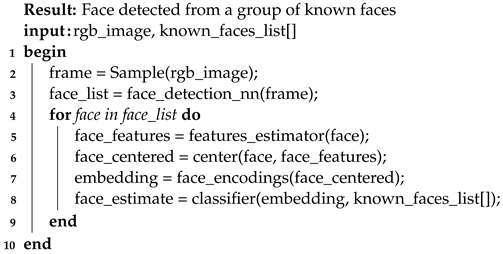 |
3.3. Person Following
- A circle of radius r, number of points and density of points is created around the target ().
- All the points are ordered by the distance to the robot.
- The points are tested to check if they are free in the costmap.
- Check if there is any obstacle between the robot and the target.
- If there are points in this circle that satisfy these conditions, the closest point to the robot is used. If there is not, r increases and the algorithm returns to step 1.
- The orientation of the robot is chosen from the calculated position towards the person.
| Algorithm 2: Person following algorithm |
 |
3.4. Pick and Placing
3.4.1. Target Object Localization
3.4.2. End-Effector Localization
3.4.3. Visual-Servo Control
3.4.4. Pick and Place Pipeline
| Algorithm 3: Person following algorithm |
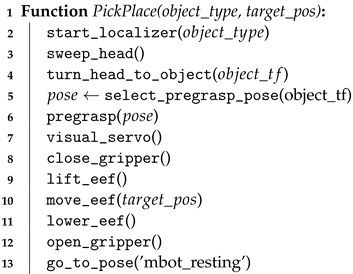 |
4. Functionality Benchmark
4.1. Automatic Benchmarking System
4.2. People Perception
- The robot is placed on a predefined location outside the specified target and is connected to the RSBB network.
- The test starts by the RSBB upon receiving the readiness signal from the robot.
- The RSBB then randomly selects a subject from the set of human targets and requests the person to move inside the area.
- After the person is in place, the operator uses the RSBB’s GUI to press the “Manual Operation Complete” button.
- The RSBB sends a request signal for the robot to start with the the functionality attempt, i.e., to detect, identify and locate the target.
- The robot then communicates the perception results to the RSBB.
- The RSBB asks the subject to move out of the area and randomly selects the next person to enter.
- The 2D position of the person with respect to the world reference frame.
- The identity of the person who is inside the target area.
- The percentage of correctly recognized peoples;
- The localization error for all the detected peoples;
- The trial’s execution time.
4.3. Person Following
- The robot is placed on the starting position in front of a person.
- The test starts by the RSBB, upon receiving the readiness signal from the robot.
- A start signal is sent by the RSBB, and the benchmark starts.
- The person starts to walk and visits a set of locations inside the arena, occasionally stopping and then resuming the walking.
- The robot is expected to maintain a desired distance with the person while avoiding obstacles and other people that can interrupt the motion of the robot.
- The benchmark is terminated after a predefined duration, and a timeout signal is sent out by the RSBB.
- : The accuracy in following and maintaining the desired relative distance to the target;
- : The total covered distance while following the target. The robot is considered to be following the target if it is within a tolerance range of the desired distance.
4.4. Pick and Placing
- 1.
- The robot is placed in front of the table.
- 2.
- The benchmark trial starts by the RSBB, after the readiness signal is received by the robot.
- 3.
- The RSBB randomly selects an item from the list of items and asks the referee to place it on the table in a random location.
- 4.
- The RSBB sends the execution request with information about the identity of the object and the desired target location.
- 5.
- The robot must then grasp, pick up and place the object on the specified target location.
- 6.
- The robot sends the complete attempt signal to the RSBB and announces its readiness for the next object.
- The percentage of correctly grasped objects. A successful grasp is automatically detected by the RSBB system once it detects that the height of the object has increased by a pre-defined threshold;
- The error in the placement position with respect to the specified target location;
- The execution time.
5. Experiments and Results
5.1. People Perception
5.2. People Following
5.3. Pick and Placing
6. Conclusions
Author Contributions
Funding
Institutional Review Board Statement
Informed Consent Statement
Data Availability Statement
Conflicts of Interest
References
- Wise, M.; Ferguson, M.; King, D.; Diehr, E.; Dymesich, D. Fetch and freight: Standard platforms for service robot applications. In Proceedings of the Workshop on Autonomous Mobile Service Robots, New York, NY, USA, 11 July 2016. [Google Scholar]
- Liu, J.; Wang, Y.; Li, B.; Ma, S. Current research, key performances and future development of search and rescue robots. Front. Mech. Eng. China 2007, 2, 404–416. [Google Scholar] [CrossRef] [Green Version]
- Bai, L.; Guan, J.; Chen, X.; Hou, J.; Duan, W. An optional passive/active transformable wheel-legged mobility concept for search and rescue robots. Robot. Auton. Syst. 2018, 107, 145–155. [Google Scholar] [CrossRef]
- Basiri, M.; Gonçalves, J.; Rosa, J.; Bettencourt, R.; Vale, A.; Lima, P. A multipurpose mobile manipulator for autonomous firefighting and construction of outdoor structures. Field Robot. 2021, 1, 102–126. [Google Scholar] [CrossRef]
- Siciliano, B.; Khatib, O. (Eds.) Domestic Robotics. In Springer Handbook of Robotics; Springer International Publishing: Cham, Switzerland, 2016; pp. 1729–1758. [Google Scholar] [CrossRef]
- Sinapov, J.; Stoytchev, A. Object category recognition by a humanoid robot using behavior-grounded relational learning. In Proceedings of the 2011 IEEE International Conference on Robotics and Automation, Shanghai, China, 9–13 May 2011; pp. 184–190. [Google Scholar] [CrossRef] [Green Version]
- Young, J.E.; Hawkins, R.; Sharlin, E.; Igarashi, T. Toward acceptable domestic robots: Applying insights from social psychology. Int. J. Soc. Robot. 2009, 1, 95–108. [Google Scholar] [CrossRef] [Green Version]
- Müller, A.C.; Behnke, S. Learning depth-sensitive conditional random fields for semantic segmentation of RGB-D images. In Proceedings of the 2014 IEEE International Conference on Robotics and Automation (ICRA), Hong Kong, China, 31 May–7 June 2014; pp. 6232–6237. [Google Scholar] [CrossRef]
- Messias, J.; Ventura, R.; Lima, P.; Sequeira, J.; Alvito, P.; Marques, C.; Carriço, P. A robotic platform for edutainment activities in a pediatric hospital. In Proceedings of the 2014 IEEE International Conference on Autonomous Robot Systems and Competitions (ICARSC), Espinho, Portugal, 14–15 May 2014; pp. 193–198. [Google Scholar] [CrossRef]
- Muszynski, S.; Stückler, J.; Behnke, S. Adjustable autonomy for mobile teleoperation of personal service robots. In Proceedings of the 2012 IEEE RO-MAN: The 21st IEEE International Symposium on Robot and Human Interactive Communication, Paris, France, 9–13 September 2012; pp. 933–940. [Google Scholar] [CrossRef]
- Gu, S.; Holly, E.; Lillicrap, T.; Levine, S. Deep reinforcement learning for robotic manipulation with asynchronous off-policy updates. In Proceedings of the 2017 IEEE International Conference on Robotics and Automation (ICRA), Singapore, 29 May–3 June 2017; pp. 3389–3396. [Google Scholar] [CrossRef] [Green Version]
- Pineda, L.A.; Salinas, L.; Meza, I.V.; Rascon, C.; Fuentes, G. Sitlog: A programming language for service robot tasks. Int. J. Adv. Robot. Syst. 2013, 10, 358. [Google Scholar] [CrossRef]
- Matamoros, M.; Seib, V.; Memmesheimer, R.; Paulus, D. RoboCup@Home: Summarizing achievements in over eleven years of competition. In Proceedings of the 2018 IEEE International Conference on Autonomous Robot Systems and Competitions (ICARSC), Torres Vedras, Portugal, 25–27 April 2018; pp. 186–191. [Google Scholar] [CrossRef] [Green Version]
- Amigoni, F.; Bastianelli, E.; Berghofer, J.; Bonarini, A.; Fontana, G.; Hochgeschwender, N.; Iocchi, L.; Kraetzschmar, G.; Lima, P.; Matteucci, M.; et al. Competitions for Benchmarking: Task and Functionality Scoring Complete Performance Assessment. IEEE Robot. Autom. Mag. 2015, 22, 53–61. [Google Scholar] [CrossRef]
- European Robotics League. Available online: https://www.eu-robotics.net/robotics_league/ (accessed on 13 October 2020).
- Basiri, M.; Piazza, E.; Matteucci, M.; Lima, P. Benchmarking Functionalities of Domestic Service Robots Through Scientific Competitions. KI-Künstliche Intell. 2019, 33, 357–367. [Google Scholar] [CrossRef]
- Stuckler, J.; Holz, D.; Behnke, S. RoboCup@Home: Demonstrating Everyday Manipulation Skills in RoboCup@Home. IEEE Robot. Autom. Mag. 2012, 19, 34–42. [Google Scholar] [CrossRef]
- Cartucho, J.; Ventura, R.; Veloso, M. Robust object recognition through symbiotic deep learning in mobile robots. In Proceedings of the 2018 IEEE/RSJ international conference on intelligent robots and systems (IROS), Madrid, Spain, 1–5 October 2018; pp. 2336–2341. [Google Scholar]
- RoCKIn: Robot Competitions Kick Innovation in Cognitive Systems. Available online: http://rockinrobotchallenge.eu (accessed on 13 December 2018).
- Lima, P.U. The RoCKIn Project. In RoCKIn: Benchmarking Through Robot Competitions; IntechOpen: London, UK, 2017; Chapter 2; p. 765. [Google Scholar] [CrossRef] [Green Version]
- Li, D.; Li, L.; Li, Y.; Yang, F.; Zuo, X. A Multi-Type Features Method for Leg Detection in 2-D Laser Range Data. IEEE Sens. J. 2018, 18, 1675–1684. [Google Scholar] [CrossRef]
- Weinrich, C.; Wengefeld, T.; Schroeter, C.; Gross, H. People detection and distinction of their walking aids in 2D laser range data based on generic distance-invariant features. In Proceedings of the 23rd IEEE International Symposium on Robot and Human Interactive Communication, Edinburgh, UK, 25–29 August 2014; pp. 767–773. [Google Scholar] [CrossRef]
- Davis, J.W.; Keck, M.A. A Two-Stage Template Approach to Person Detection in Thermal Imagery. In Proceedings of the 2005 Seventh IEEE Workshops on Applications of Computer Vision (WACV/MOTION’05)—Volume 1, Breckenridge, CO, USA, 5–7 January 2005; Volume 1, pp. 364–369. [Google Scholar] [CrossRef]
- Nguyen, D.T.; Li, W.; Ogunbona, P.O. Human detection from images and videos: A survey. Pattern Recognit. 2016, 51, 148–175. [Google Scholar] [CrossRef]
- Shotton, J.; Girshick, R.; Fitzgibbon, A.; Sharp, T.; Cook, M.; Finocchio, M.; Moore, R.; Kohli, P.; Criminisi, A.; Kipman, A.; et al. Efficient Human Pose Estimation from Single Depth Images. IEEE Trans. Pattern Anal. Mach. Intell. 2013, 35, 2821–2840. [Google Scholar] [CrossRef] [PubMed]
- Muñoz-Salinas, R.; Aguirre, E.; García-Silvente, M. People detection and tracking using stereo vision and color. Image Vis. Comput. 2007, 25, 995–1007. [Google Scholar] [CrossRef]
- Martinel, N.; Luca Foresti, G.; Micheloni, C. Aggregating deep pyramidal representations for person re-identification. In Proceedings of the IEEE/CVF Conference on Computer Vision and Pattern Recognition Workshops, Long Beach, CA, USA, 16–17 June 2019. [Google Scholar]
- Zhu, Z.; Jiang, X.; Zheng, F.; Guo, X.; Huang, F.; Sun, X.; Zheng, W. Viewpoint-Aware Loss with Angular Regularization for Person Re-Identification. AAAI Conf. Artif. Intell. 2020, 34, 13114–13121. [Google Scholar] [CrossRef]
- Haque, A.; Alahi, A.; Li, F.-F. Recurrent Attention Models for Depth-Based Person Identification. In Proceedings of the IEEE Conference on Computer Vision and Pattern Recognition (CVPR), Las Vegas, NV, USA, 27–30 June 2016. [Google Scholar]
- Ye, M.; Shen, J.; Crandall, D.; Shao, L.; Luo, J. Dynamic Dual-Attentive Aggregation Learning for Visible-Infrared Person Re-identification. In Computer Vision—ECCV 2020; Vedaldi, A., Bischof, H., Brox, T., Frahm, J.M., Eds.; Springer International Publishing: Cham, Switzerland, 2020; pp. 229–247. [Google Scholar]
- Gupta, M.; Kumar, S.; Behera, L.; Subramanian, V.K. A Novel Vision-Based Tracking Algorithm for a Human-Following Mobile Robot. IEEE Trans. Syst. Man Cybern. Syst. 2017, 47, 1415–1427. [Google Scholar] [CrossRef]
- Xing, G.; Tian, S.; Sun, H.; Liu, W.; Liu, H. People-following system design for mobile robots using kinect sensor. In Proceedings of the 2013 25th Chinese Control and Decision Conference (CCDC), Guiyang, China, 25–27 May 2013; pp. 3190–3194. [Google Scholar] [CrossRef]
- Susperregi, L.; Martínez-Otzeta, J.M.; Ansuategui, A.; Ibarguren, A.; Sierra, B. RGB-D, laser and thermal sensor fusion for people following in a mobile robot. Int. J. Adv. Robot. Syst. 2013, 10, 271. [Google Scholar] [CrossRef]
- Basiri, M.; Gonçalves, J.; Rosa, J.; Vale, A.; Lima, P. An autonomous mobile manipulator to build outdoor structures consisting of heterogeneous brick patterns. SN Appl. Sci. 2021, 3, 558. [Google Scholar] [CrossRef]
- Kumar, R.; Lal, S.; Kumar, S.; Chand, P. Object detection and recognition for a pick and place robot. In Proceedings of the Asia-Pacific World Congress on Computer Science and Engineering, Nadi, Fiji, 4–5 November 2014; pp. 1–7. [Google Scholar]
- Lozano-Pérez, T.; Jones, J.L.; Mazer, E.; O’Donnell, P.A. Task-level planning of pick-and-place robot motions. Computer 1989, 22, 21–29. [Google Scholar] [CrossRef]
- Hutchinson, S.; Hager, G.D.; Corke, P.I. A tutorial on visual servo control. IEEE Trans. Robot. Autom. 1996, 12, 651–670. [Google Scholar] [CrossRef] [Green Version]
- Collewet, C.; Marchand, E. Photometric Visual Servoing. IEEE Trans. Robot. 2011, 27, 828–834. [Google Scholar] [CrossRef] [Green Version]
- Bateux, Q.; Marchand, E.; Leitner, J.; Chaumette, F.; Corke, P. Training Deep Neural Networks for Visual Servoing. In Proceedings of the 2018 IEEE International Conference on Robotics and Automation (ICRA), Brisbane, Australia, 21–25 May 2018; pp. 3307–3314. [Google Scholar] [CrossRef] [Green Version]
- Lenz, I.; Lee, H.; Saxena, A. Deep learning for detecting robotic grasps. Int. J. Robot. Res. 2015, 34, 705–724. [Google Scholar] [CrossRef] [Green Version]
- Levine, S.; Finn, C.; Darrell, T.; Abbeel, P. End-to-end training of deep visuomotor policies. J. Mach. Learn. Res. 2016, 17, 1334–1373. [Google Scholar]
- Kalashnikov, D.; Irpan, A.; Pastor, P.; Ibarz, J.; Herzog, A.; Jang, E.; Quillen, D.; Holly, E.; Kalakrishnan, M.; Vanhoucke, V.; et al. Scalable Deep Reinforcement Learning for Vision-Based Robotic Manipulation. In Proceedings of the 2018 Conference on Robot Learning, Zurich, Switzerland, 29–31 October 2018; pp. 651–673. [Google Scholar]
- Ventura, R.; Basiri, M.; Mateus, A.; Garcia, J.; Miraldo, P.; Santos, P.; Lima, P. A domestic assistive robot developed through robot competitions. In Ijcai 2016 Workshop on Autonomous Mobile Service Robots; Intelligent Robots and Systems Group (IRSg): New York, NY, USA, 2016. [Google Scholar]
- Redmon, J.; Divvala, S.; Girshick, R.; Farhadi, A. You Only Look Once: Unified, Real-Time Object Detection. In Proceedings of the IEEE Conference on Computer Vision and Pattern Recognition (CVPR), Las Vegas, NV, USA, 27–30 June 2016. [Google Scholar]
- Lima, P.U.; Azevedo, C.; Brzozowska, E.; Cartucho, J.; Dias, T.J.; Gonçalves, J.; Kinarullathil, M.; Lawless, G.; Lima, O.; Luz, R.; et al. SocRob@ Home. KI-Künstliche Intell. 2019, 33, 343–356. [Google Scholar] [CrossRef]
- Geitgey, A. Face Recognition. Available online: https://github.com/ageitgey/face_recognition (accessed on 10 September 2020).
- Dalal, N.; Triggs, B. Histograms of oriented gradients for human detection. In Proceedings of the 2005 IEEE Computer Society Conference on Computer Vision and Pattern Recognition (CVPR’05), San Diego, CA, USA, 20–25 June 2005; Volume 1, pp. 886–893. [Google Scholar] [CrossRef] [Green Version]
- Kazemi, V.; Sullivan, J. One Millisecond Face Alignment with an Ensemble of Regression Trees. In Proceedings of the IEEE Conference on Computer Vision and Pattern Recognition (CVPR), Columbus, OH, USA, 23–28 June 2014. [Google Scholar]
- Schroff, F.; Kalenichenko, D.; Philbin, J. FaceNet: A Unified Embedding for Face Recognition and Clustering. In Proceedings of the IEEE Conference on Computer Vision and Pattern Recognition (CVPR), Boston, MA, USA, 7–12 June 2015. [Google Scholar]
- ALVAR. Library for Virtual and Augmented Reality. Available online: http://virtual.vtt.fi/virtual/proj2/multimedia/alvar/ (accessed on 5 November 2020).

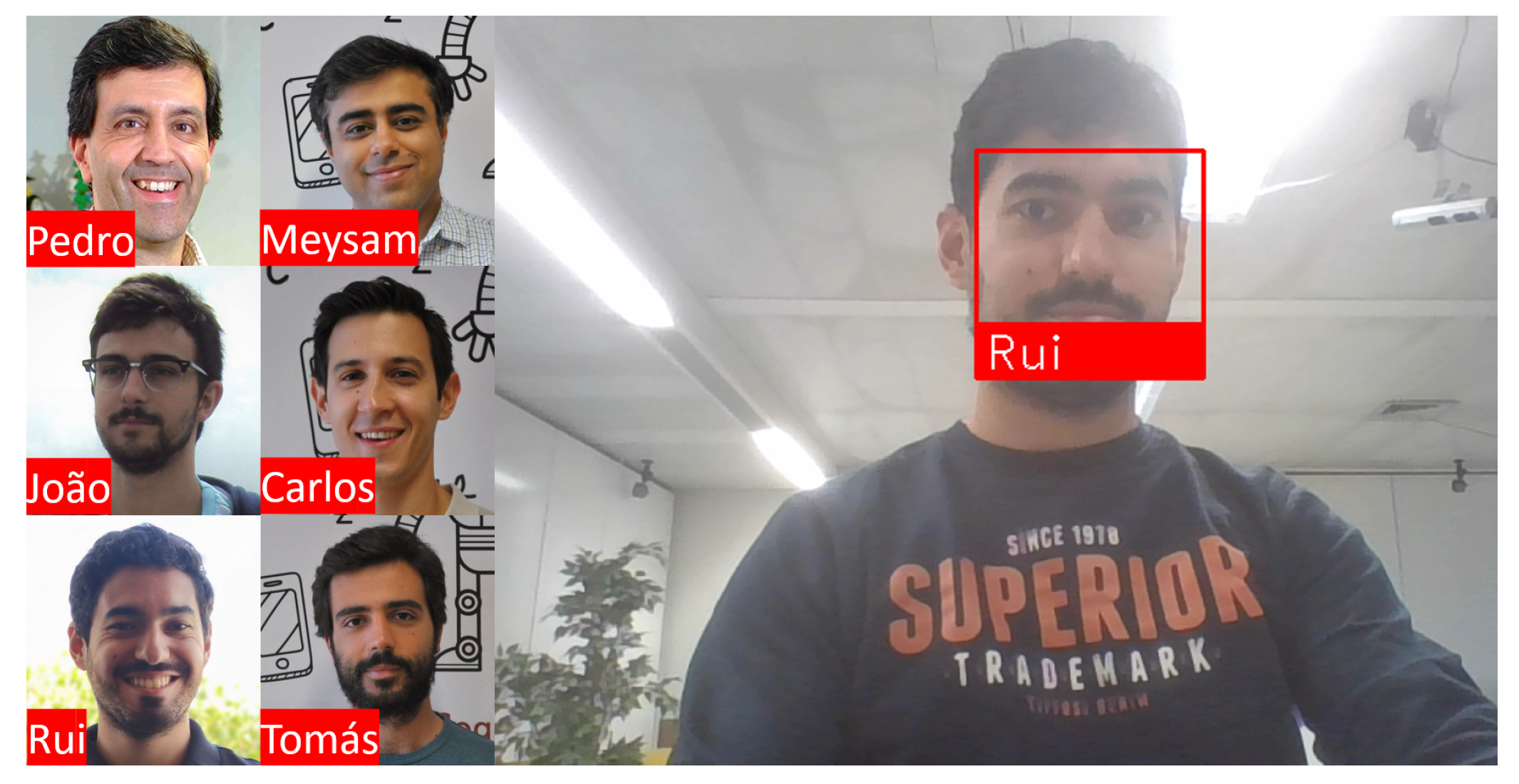

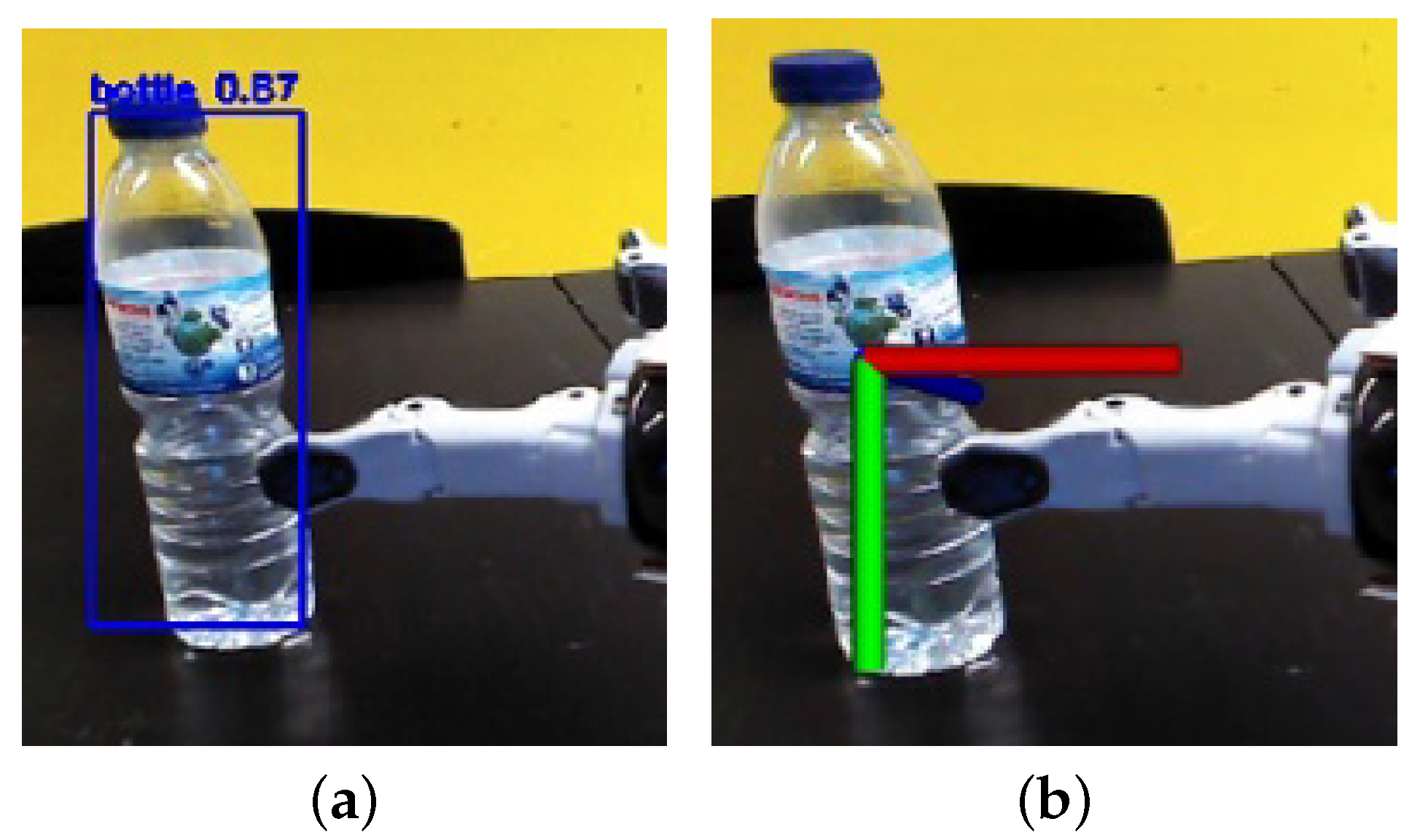
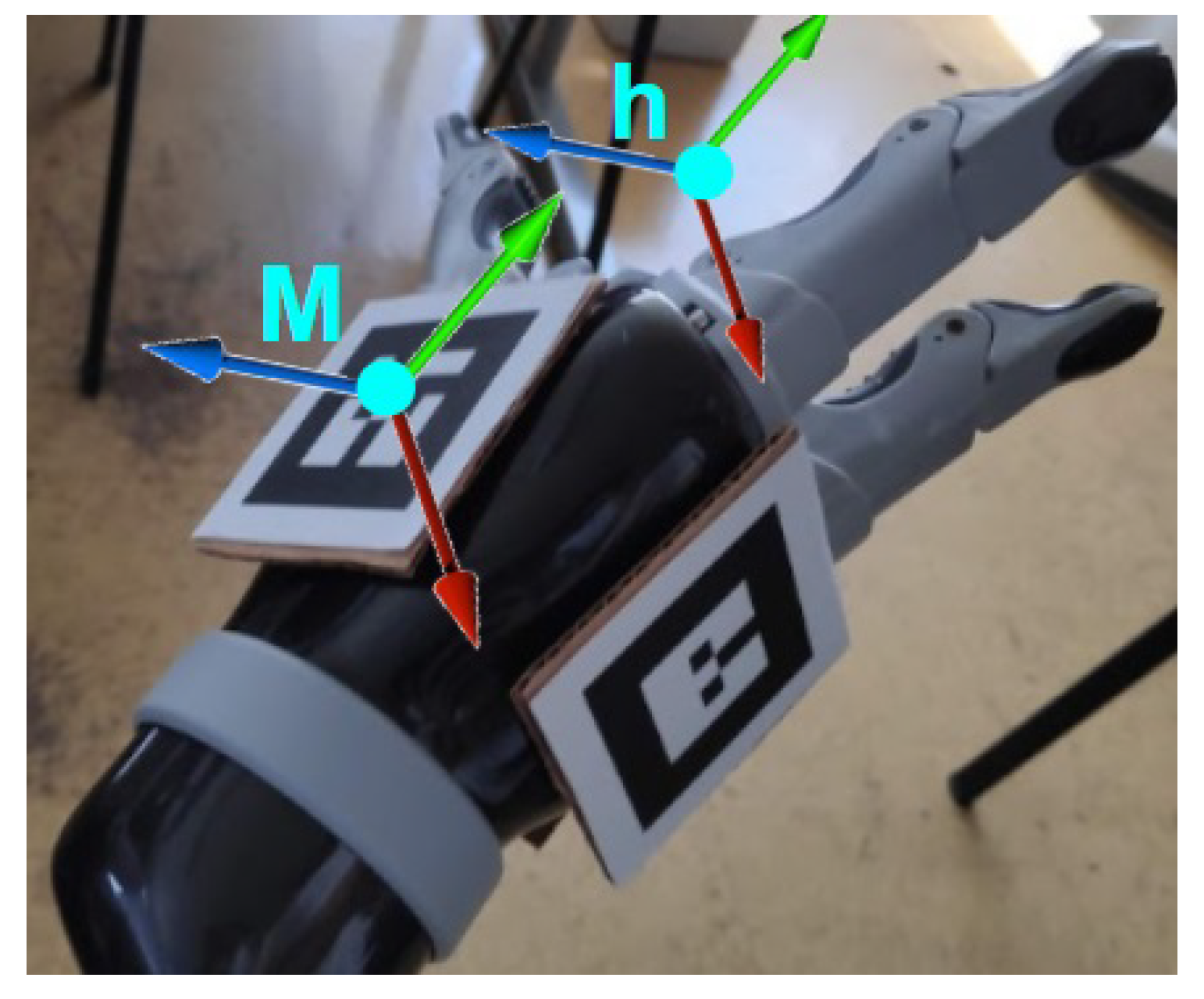


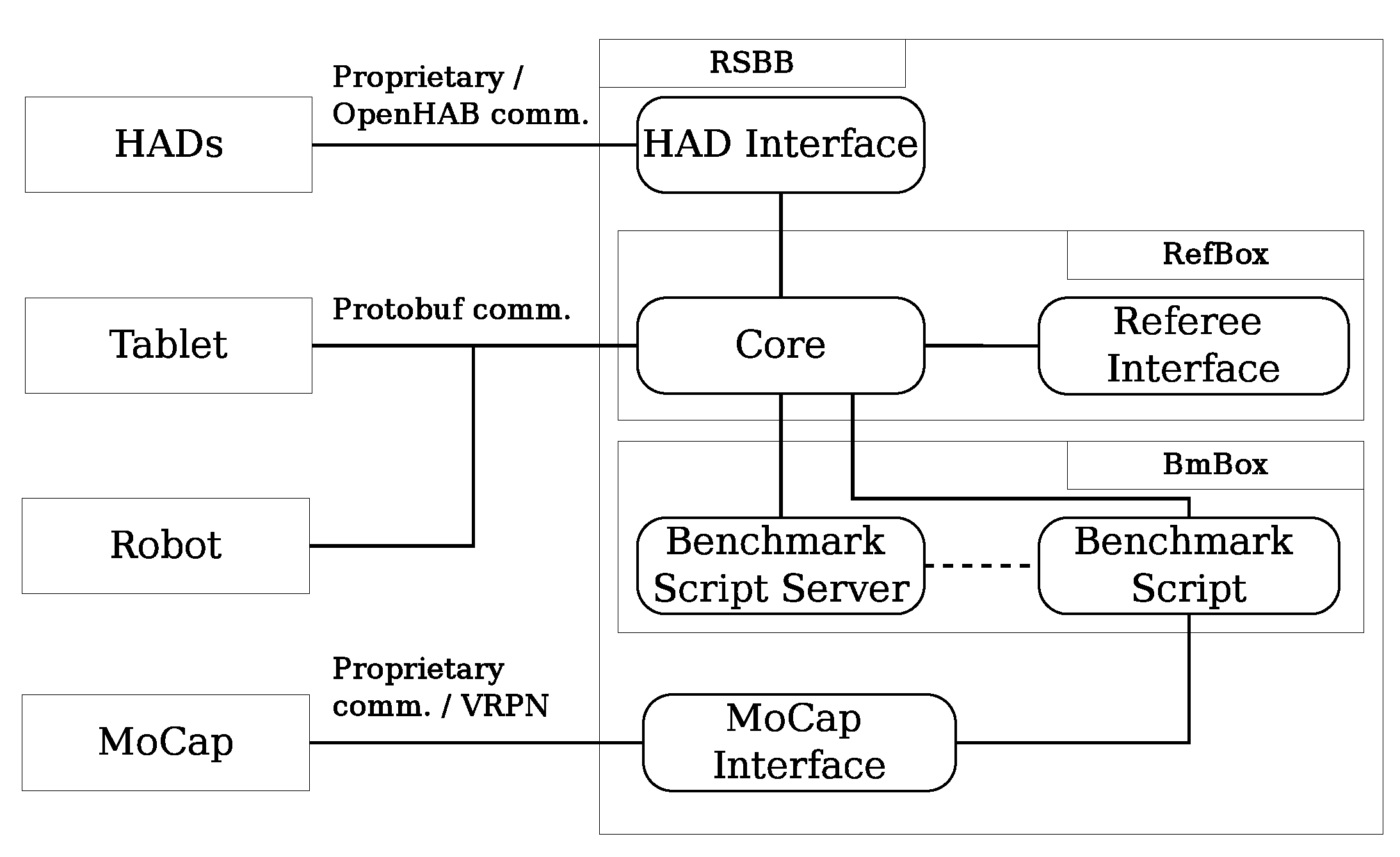
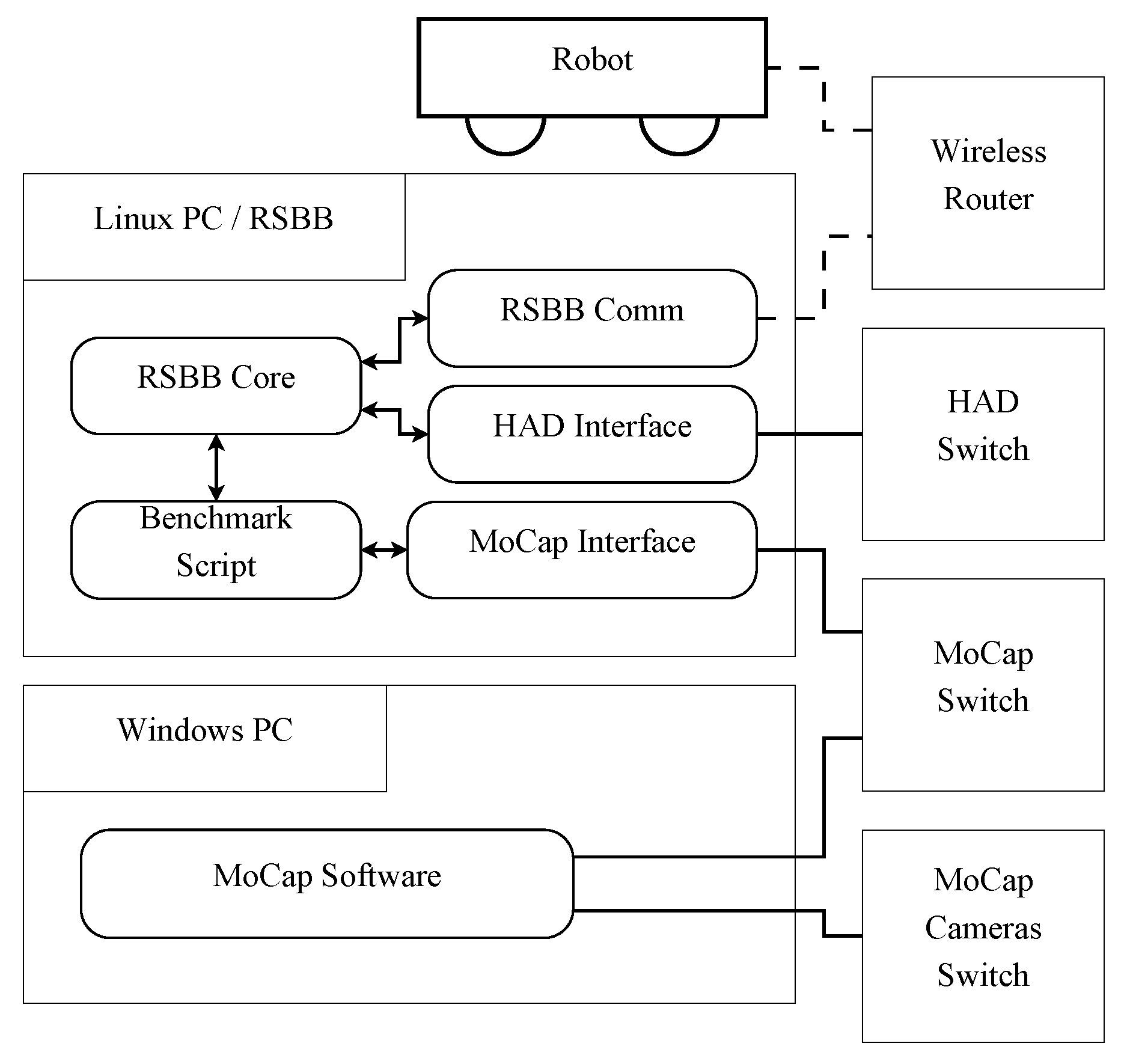
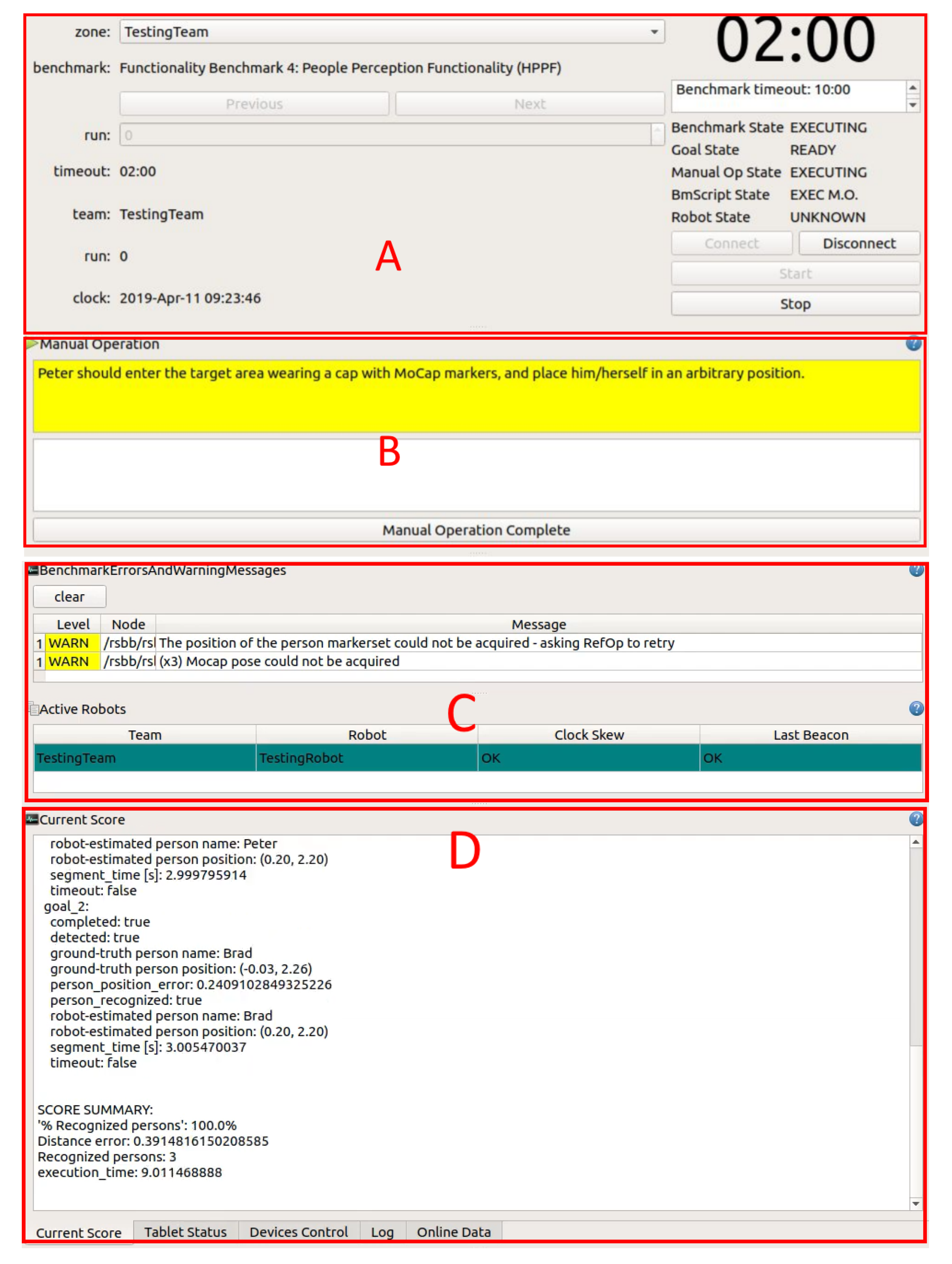
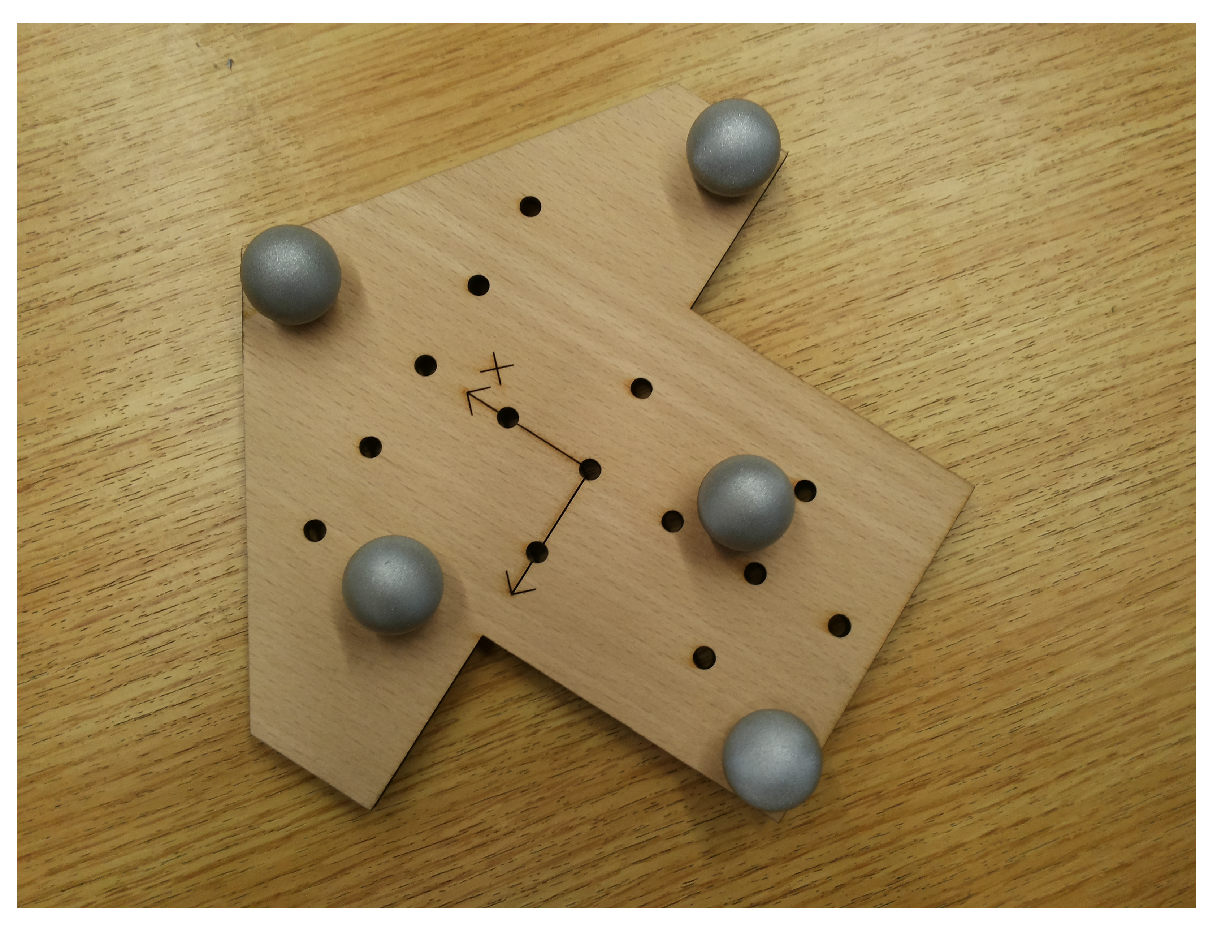
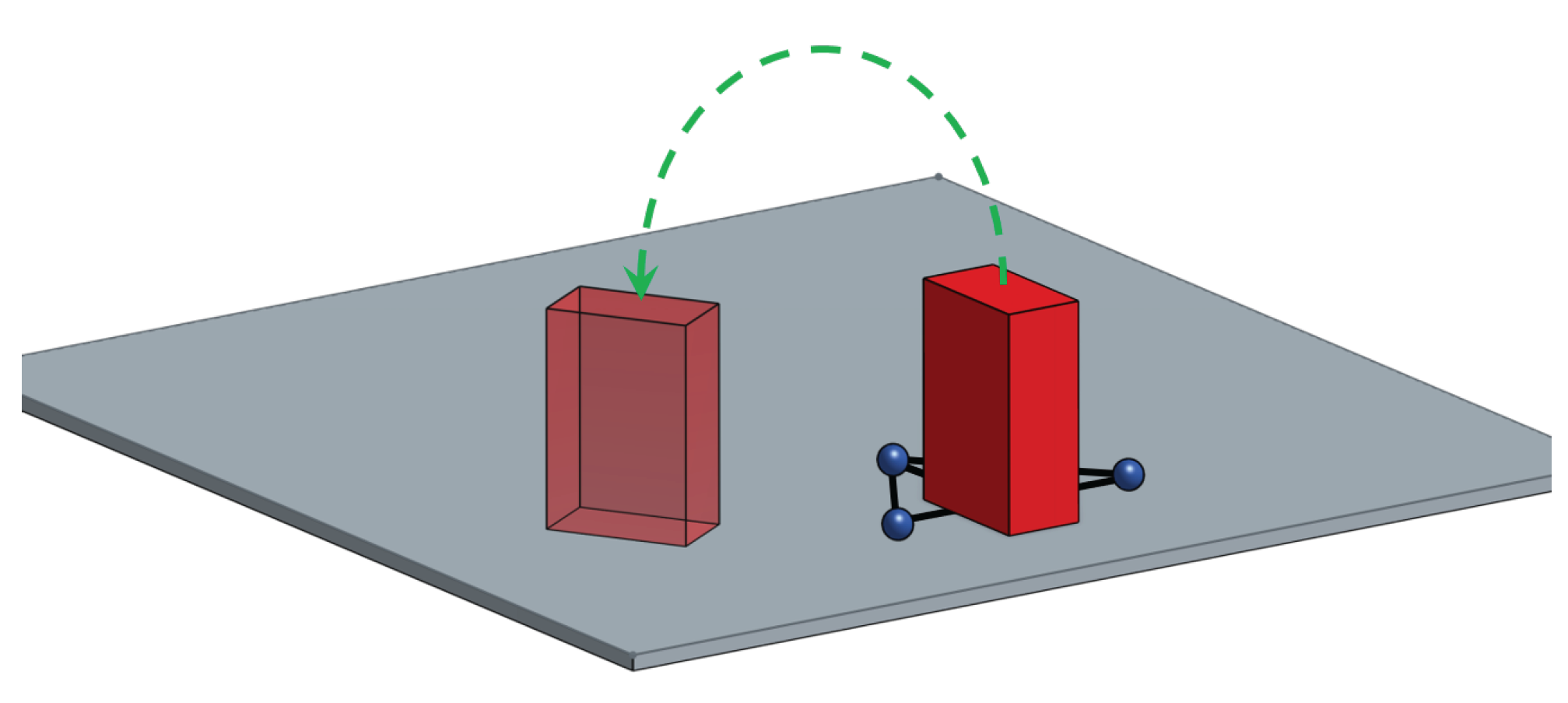
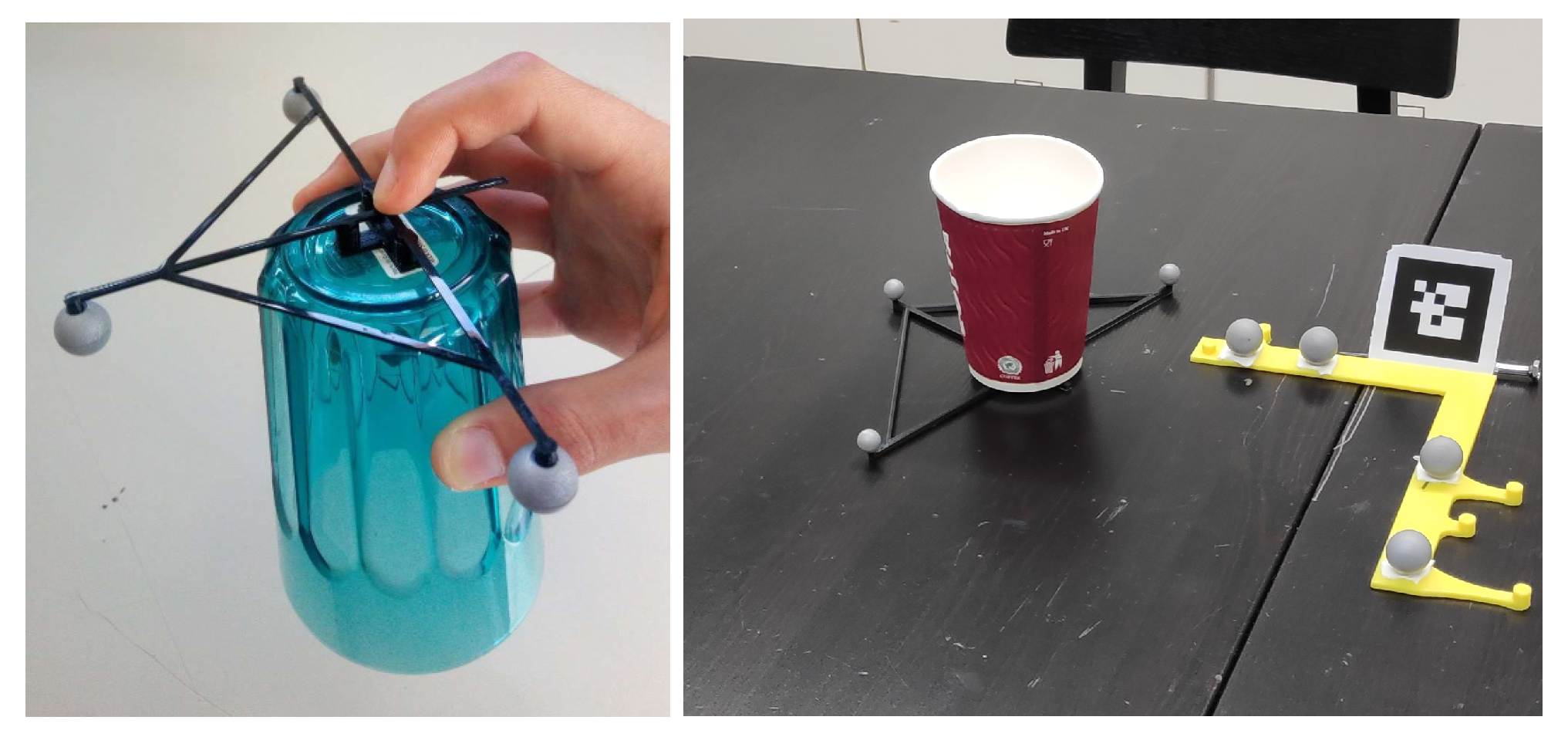
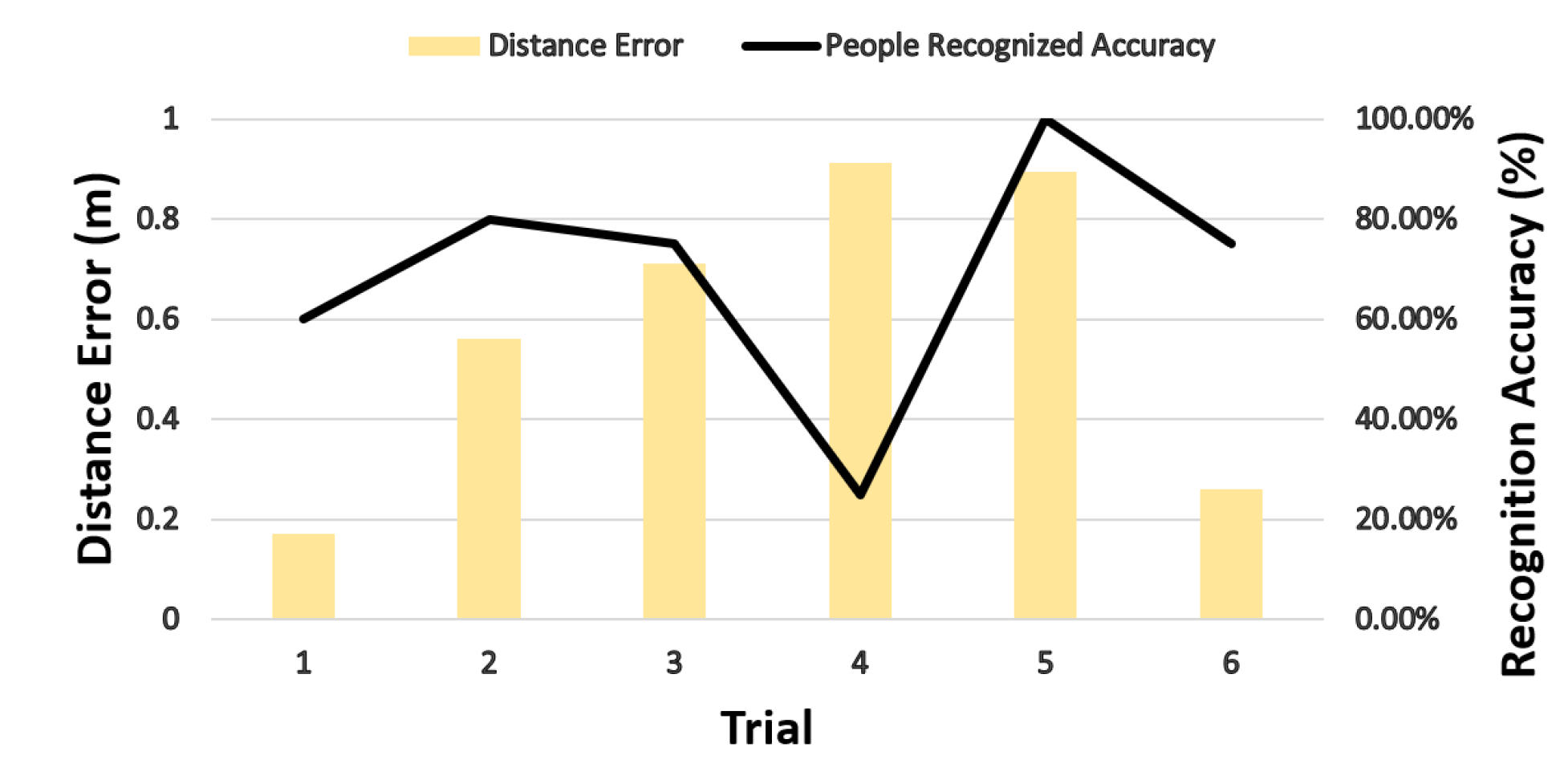
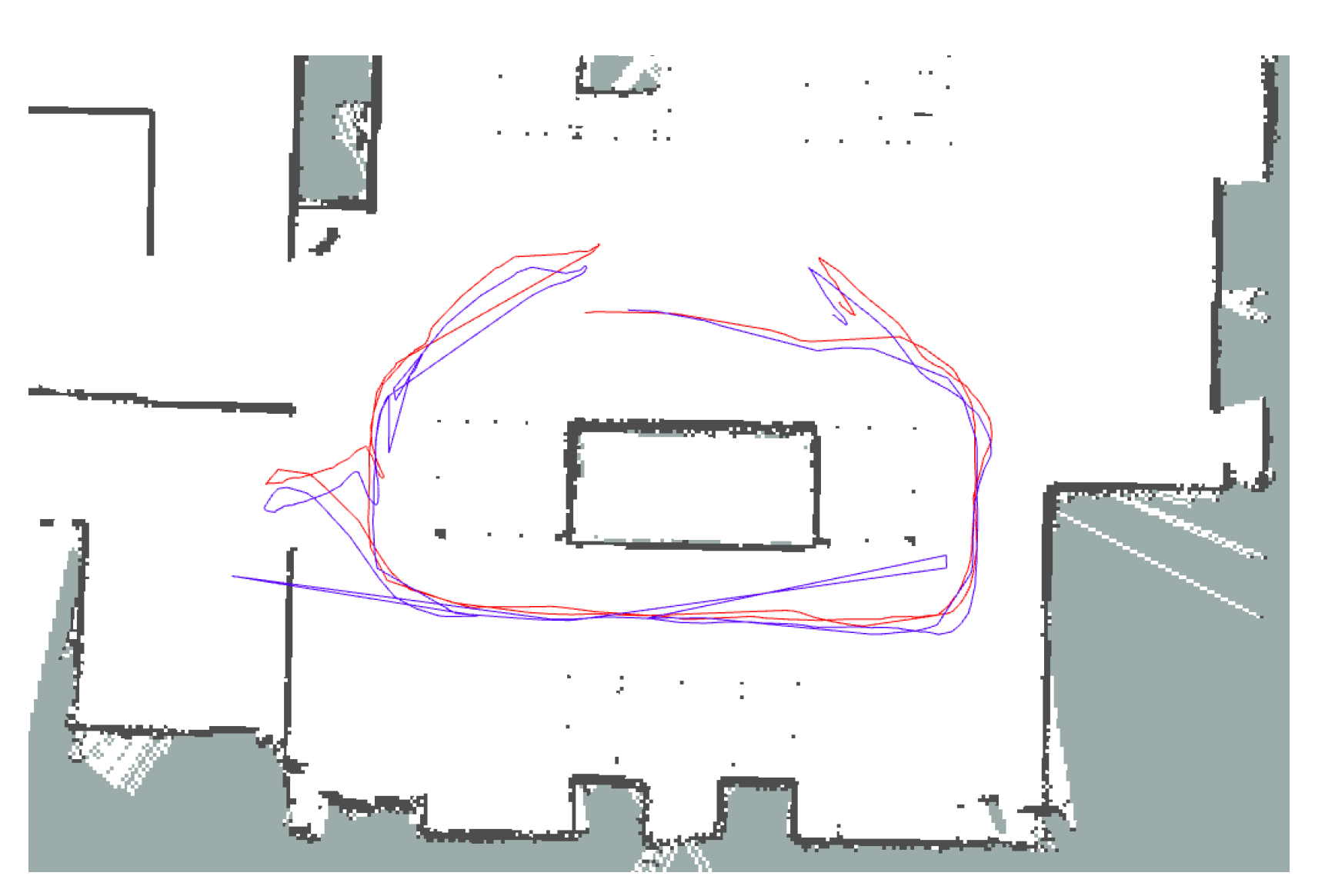
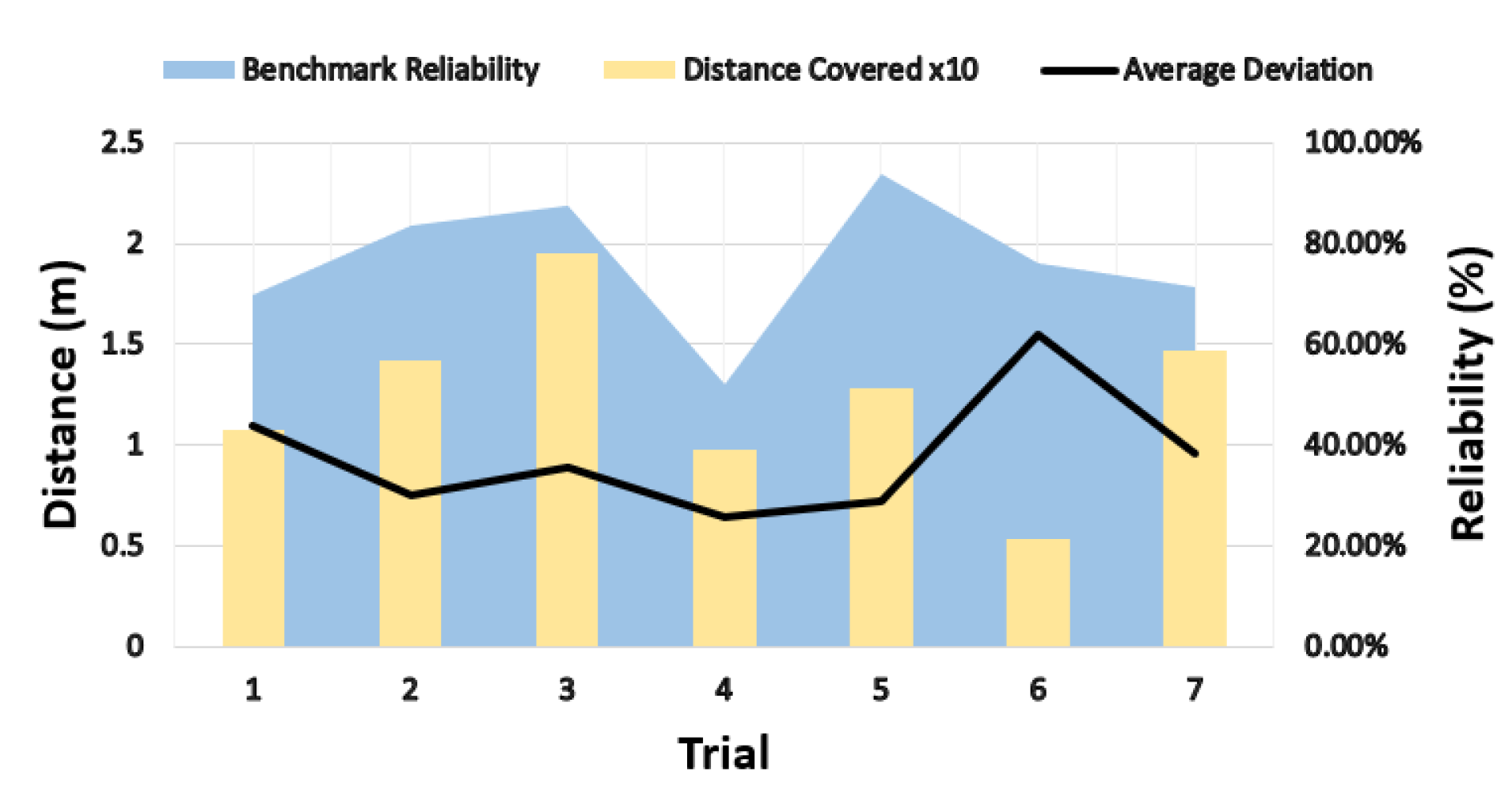
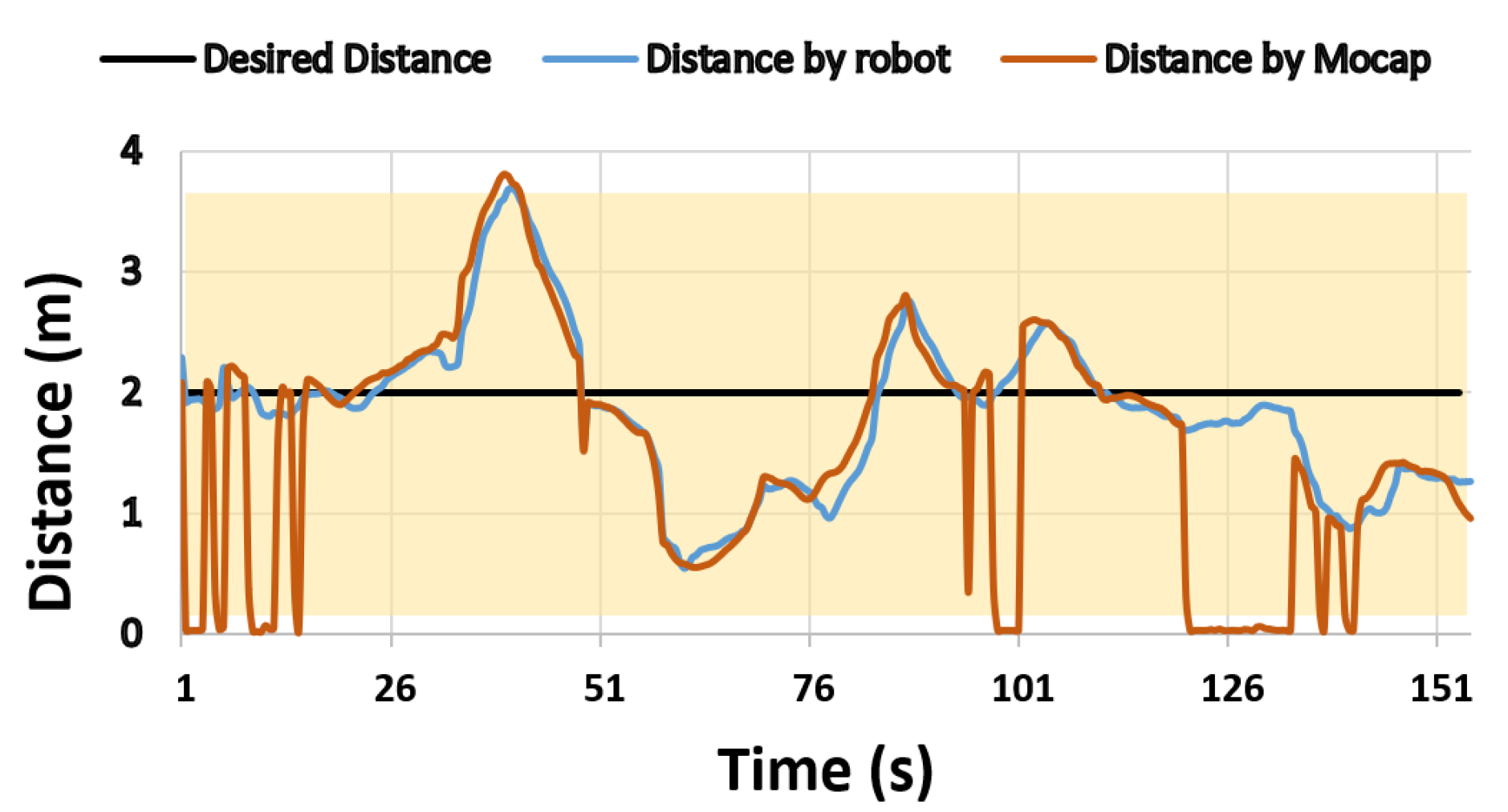

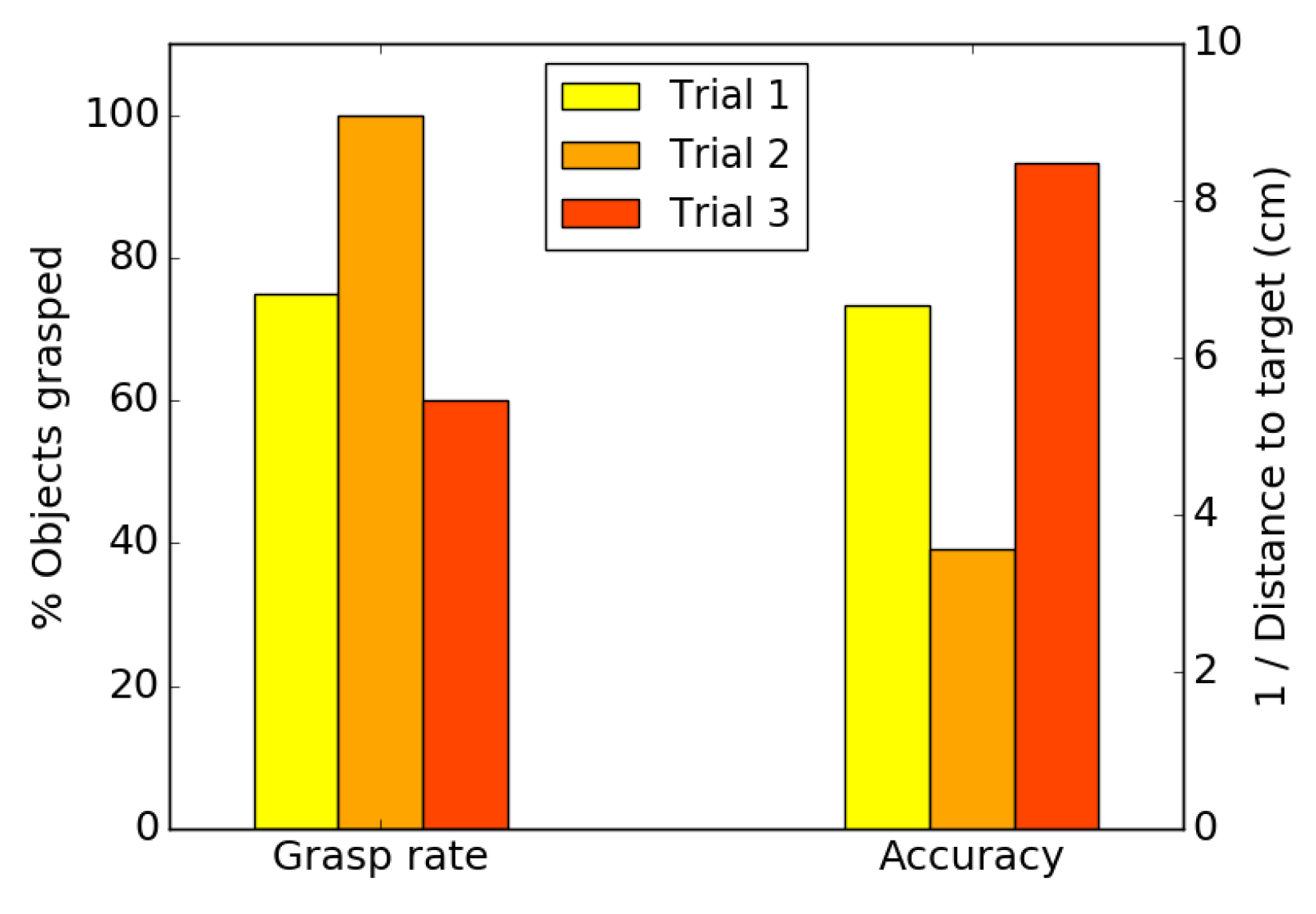
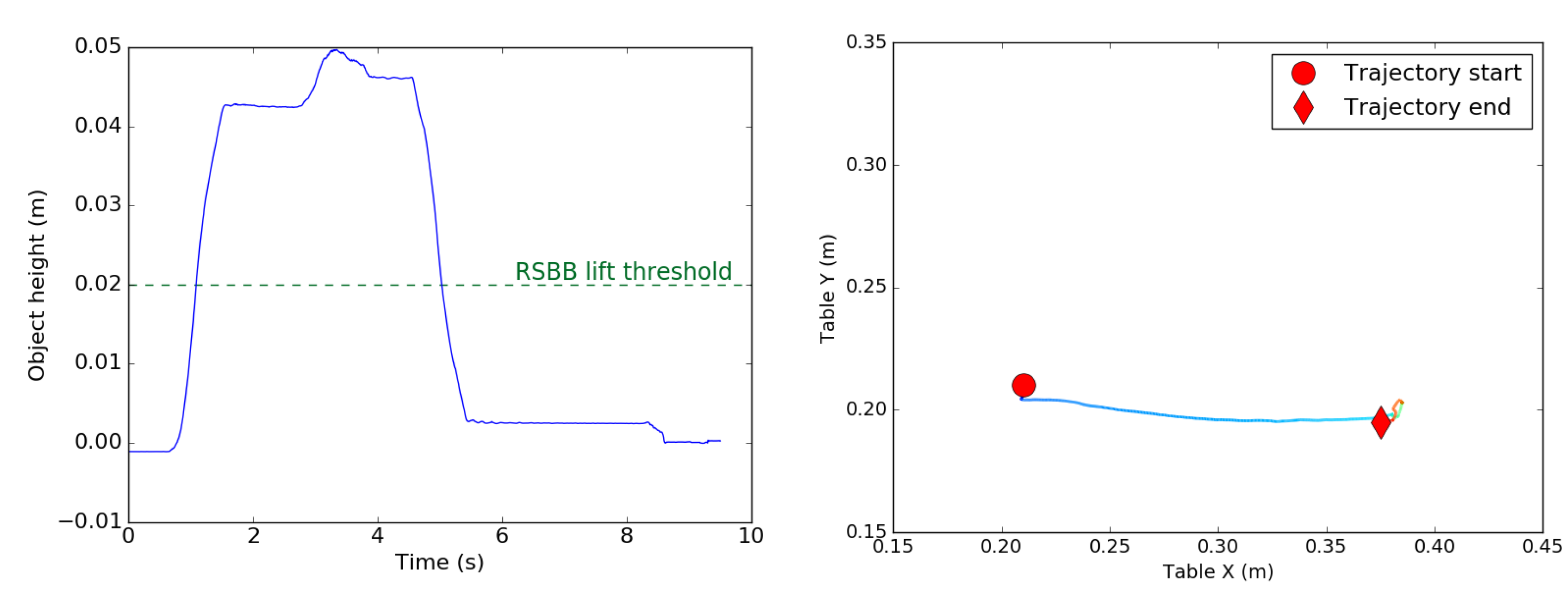
| Position Error | Detection | Time | |
|---|---|---|---|
| Person 1 | 0.1918 m | 0% | 9.0 s |
| Person 2 | 0.0735 m | 100% | 10.7 s |
| Person 3 | 0.1481 m | 0% | 7.5 s |
| Person 4 | 0.1916 m | 100% | 11.2 s |
| Person 5 | 0.2502 m | 100% | 11.2 s |
| Trial Result | 0.1710 m | 60% | 9.9 s |
Publisher’s Note: MDPI stays neutral with regard to jurisdictional claims in published maps and institutional affiliations. |
© 2022 by the authors. Licensee MDPI, Basel, Switzerland. This article is an open access article distributed under the terms and conditions of the Creative Commons Attribution (CC BY) license (https://creativecommons.org/licenses/by/4.0/).
Share and Cite
Basiri, M.; Pereira, J.; Bettencourt, R.; Piazza, E.; Fernandes, E.; Azevedo, C.; Lima, P. Functionalities, Benchmarking System and Performance Evaluation for a Domestic Service Robot: People Perception, People Following, and Pick and Placing. Appl. Sci. 2022, 12, 4819. https://doi.org/10.3390/app12104819
Basiri M, Pereira J, Bettencourt R, Piazza E, Fernandes E, Azevedo C, Lima P. Functionalities, Benchmarking System and Performance Evaluation for a Domestic Service Robot: People Perception, People Following, and Pick and Placing. Applied Sciences. 2022; 12(10):4819. https://doi.org/10.3390/app12104819
Chicago/Turabian StyleBasiri, Meysam, João Pereira, Rui Bettencourt, Enrico Piazza, Emanuel Fernandes, Carlos Azevedo, and Pedro Lima. 2022. "Functionalities, Benchmarking System and Performance Evaluation for a Domestic Service Robot: People Perception, People Following, and Pick and Placing" Applied Sciences 12, no. 10: 4819. https://doi.org/10.3390/app12104819
APA StyleBasiri, M., Pereira, J., Bettencourt, R., Piazza, E., Fernandes, E., Azevedo, C., & Lima, P. (2022). Functionalities, Benchmarking System and Performance Evaluation for a Domestic Service Robot: People Perception, People Following, and Pick and Placing. Applied Sciences, 12(10), 4819. https://doi.org/10.3390/app12104819








